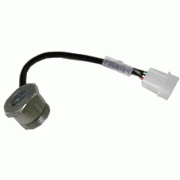 Based on the model of the magneto installed in your aircraft, there are several different models / types of RPM standard sensors for aircraft. The RPM standard sensors you select and use would therefore depend on the brand of magneto in your aircraft.
Based on the model of the magneto installed in your aircraft, there are several different models / types of RPM standard sensors for aircraft. The RPM standard sensors you select and use would therefore depend on the brand of magneto in your aircraft.
Typical RPM standard sensors (as manufactured by J P Instruments) include:
RPM Standard Sensor for pressurized BENDIX 1200 SERIES (JPI part # 10-05459)
RPM Standard Sensor for pressurized BENDIX 20 SERIES (JPI part # 10-05460)
RPM Standard Sensor for pressurized BENDIX DUAL MAG SERIES (JPI part # 10-05461)
RPM Standard Sensor for VENT PLUG SENSOR for BENDIX (JPI part # 10-05651) and,
RPM Standard Sensor for VENT PLUG SENSOR for SLICK (JPI part # 10-05652).
From the year 2002 onwards, IO-550 magnetos usually have a compatible RPM sensor installed (running on 5v), but you can opt for the better-quality RPM standard sensor manufactured by JPI.
Since we can’t write on each and every one of the RPM standard sensors, let us concentrate on the more popular RPM standard sensor for the pressurized Bendix series (manufactured by Teledyne Continental Motors).
Being simple in construct, the Bendix Magneto RPM standard sensors is easily maintained and therefore quite cost effective. Also, the Bendix Magneto RPM standard sensors manufactured by J.P. Instruments is highly accurate.
If you have just acquired an aircraft of your own and are not sure of the importance of the Engine Monitors – here’s what it does:
The aircraft has sparkplugs and these require high voltage power. Rather than rely on the aircraft battery, the power to the spark plugs comes from a mini power generator called the ‘Magneto‘ - of which, there are different brands; the Bendix brand being more popular. The Bendix Magneto is a small power generator that has a built-in breaker switch, a transformer and a distribution system to channel the power to the spark plugs.
This power generator has a rotating magnet inside and it is important that it rotates at a speed that is within the prescribed range otherwise your spark plugs (and hence the engine) will misfire. To ensure all is well, you need the aircraft RPM Sensor. The RPM standard Sensor plugs directly into the magneto and transmits data to your Aircraft Engine Monitoring Systems in the cockpit.
It is important to have a good quality RPM standard sensor as it helps identify / eliminate the magneto as the source of engine problem.
When fitting your new RPM standard sensor, make sure:
• The RPM Sensor is aligned with the correct vent plug of the magneto (if you peep through, you should see the rotating magnet in this hole. If you see a ‘gear’ you’re on the wrong vent).
• A 4 cylinder engine should read 3600 rpm, a 6 cylinder engine should read 2400 rpm, a 8 cylinder should read 1800 rpm while a 9 cylinder engine should have an rpm of 1600. A 4 cylinder dual mag engine should have rpm of 1800 and a 6 cylinder dual mag should have rpm of 2400.
• The red wire to the RPM standard sensors should be supplying 5v+.
More information on JPI manufactured RPM standard sensors here: https://www.jpinstruments.com/shop/rpm-sensor-for-bendix-mag/

